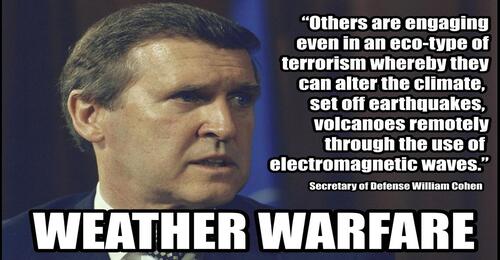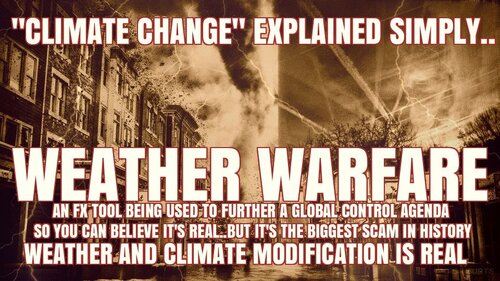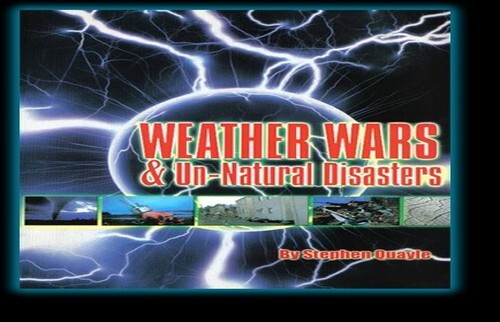|
September 20, 2021�
Fully Weaponizing Weather To Attack The US Power Grid Would Completely Obliterate Our Critical Infrastructure, Sow Protracted Chaos And Attack Our Psychological Achilles Heel

By Dr Peter Vincent Pry for All News Pipeline�
KEY JUDGMENTS�
An attack on the U.S. electric power grid, with the objective of causing a regional or nationwide protracted blackout, is likely to exploit severe weather as a weapon. Hurricanes, heat waves, ice storms, tornadoes, summer temperature highs and winter lows, and other weather extremes, can stress electric grids and tax emergency resources, facilitating attacks by cyber, sabotage, and EMP to orchestrate a protracted blackout.�
Exploiting severe weather to wage a �blackout war� offers numerous strategic, tactical, and operational advantages supporting a combined-arms cyber, sabotage, and EMP attack.�
Storm-induced blackouts of the electric power grid are suggestive of the possible consequences of a �blackout war� such as could be waged against the United States by Russia, China, North Korea, Iran and/or international terrorists.�
Electric power grid failure caused by storms cascade through other critical infrastructures�such as communications, transportation, emergency medical services, food and water supply systems. Storm-induced blackouts provide an objective basis for extrapolating judgments about the threat posed by �blackout warfare� to the civilian infrastructures that sustain economic, political, and social life.�
�Blackout warfare� is likely to damage or disrupt electronics over a much wider geographic area than storm-induced blackouts�potentially over most of North America. Nor do storm-induced blackouts replicate the damage from a nuclear EMP attack that may occur in small-scale electronic systems such as computers, aircraft, and automobiles. Storms are merely suggestive of, and provide some basis for extrapolating, the greater destructive effects on critical infrastructures and social order by a �blackout war� employing cyber-attack, sabotage, and EMP.�
Unlike �blackout warfare� hurricanes and other storms are familiar to the public and understood to be acts of nature, not the destructive agents of a foreign enemy. Public perceptions of and reactions to mass destruction differ markedly when the agent of destruction is a familiar natural event or accident, versus destruction by unfamiliar means inflicted by malignant actors.�
�Blackout warfare� against U.S. electric grids and other life-sustaining critical infrastructures would attack not only the U.S. technological Achilles heel, but by sowing protracted chaos in the homeland, attacks America�s psychological Achilles heel.�
The history of storm-induced electric power blackouts that collapse other critical infrastructures and sow societal chaos, and the long record of inadequate preparation and response by Federal and State governments and electric utilities, is for potential adversaries planning EMP and Cyber Warfare an intelligence treasure trove.�
If the largest electric utilities in the United States cannot be trusted competently to perform such basic and simple public safety precautions as vegetation management and powerline protection from high-winds and ice storms�as in California (2019) and Texas (2021)�clearly they are incompetent to protect the grid from more complex and much bigger threats, like EMP and Cyber Warfare, that could kill millions.

BLACKOUT WARFARE: WEAPONIZING WEATHER TO ATTACK THE U.S. ELECTRIC POWER GRID�
Weaponizing the Weather�
An attack on the U.S. electric power grid, with the objective of causing a regional or nationwide protracted blackout, is likely to exploit severe weather as a weapon. Hurricanes, heat waves, ice storms, tornadoes, summer temperature highs and winter lows, and other weather extremes, can stress electric grids and tax emergency resources, facilitating attacks by cyber, sabotage, and EMP to orchestrate a protracted blackout.�
Severe weather may not cooperate with an aggressor�s plans to wage a �blackout war� against the U.S. during a fast-breaking international crisis, and is not a necessary condition for attacking electric grids. Indeed, cyber-attacks, sabotage, or EMP attack alone are each potentially capable of inflicting a nationwide blackout. Nonetheless, a conservative military planner is likely to exploit the synergistic effects of all these threat vectors in a combined-arms operation to maximize damage and prospects for paralyzing the U.S. through �blackout warfare��including by exploiting severe weather.�
Military history abounds with examples of �weaponizing� weather to prevail in war:�
--480 BC the Battle of Salamis, ranked as one of the most important battles in world history, Athenian naval commander Themistocles used superior knowledge of local winds to defeat the Persian navy and thwart King Xerxes� attempt to conquer the free Greek city-states.�
--1274 and 1284 AD typhoons, called Kamikaze �divine winds� by Japan, sank and scattered huge invasion fleets from Mongol Emperor Kublai Khan�s China, enabling badly outnumbered samurai to defend Japan�s independence.�
--1588 the Spanish Armada�s planned conquest of England is thwarted by superior British seamanship exploiting a �Protestant wind� that scatters Spain�s fleet and makes invasion impossible.�
--1776 after losing the Battle of Long Island, General George Washington saves his Continental Army and the American Revolution from annihilation by evacuating across the East River under cover of night and fog in �America�s Dunkirk.��
--1709, 1812, 1941 Russia exploits �general winter� to defeat invasions by Sweden�s Charles XII, Napoleon, and Hitler.�
--1945 cloudy skies over Kokura, Japan, spared the city from atomic bombing, but sealed the fate of secondary target, clear-skied Nagasaki.�

Today, exploiting severe weather to wage a �blackout war� offers numerous strategic, tactical, and operational advantages supporting a combined-arms cyber, sabotage, and EMP attack:�
Strategic Surprise: Political and military leaders in peacetime would be distracted, and might be distracted even if in the midst of an international crisis, by a hurricane or other severe weather that becomes a natural disaster and domestic crisis. Strategic surprise attack against the national electric grid would be easier to achieve. 1 Laura Lee, �10 Surprising Ways Weather Has Changed History� www.livescience.com (4 October 2006).
Strategic Surprise: During extreme severe weather that becomes a natural disaster, electric utilities are usually overwhelmed and must be helped by emergency crews and resources from utilities located in neighboring States, sometimes nationwide. Consequently, other States are stripped of emergency resources to cope with an attack against their electric grids.�
Strategic Surprise: During extreme weather that becomes a natural disaster, electric utilities are often overwhelmed and must be helped by U.S. Government emergency resources, including from the Federal Emergency Management Agency, Department of Homeland Security, and Department of Defense. Consequently, Federal emergency resources would be less available or unavailable to cope with an attack on the electric grids of other States.�
Operational Surprise: During severe weather electric utilities typically lower or drop cybersecurity safeguards to facilitate remote access to control systems in order to increase system nimbleness responding to the stresses of severe weather. Cyber-blackout becomes easier to achieve: �Recent Texas power outages and the loss of both electricity and water across Texas demonstrate how vulnerable ERCOT and Texas are to natural disasters such as snowstorms and hurricanes but also manmade and malicious activities...it also demonstrates the vulnerability of the entire U.S. energy grid...Closer analysis shows the same effects created by natural disasters can also be triggered by adversaries able to create the same disruptions and cascading effects by exploiting control systems (e.g., SCADA systems, plant distributed control systems, controllers, relays, process instrumentation, etc.). Cyber vulnerabilities are often more exposed during natural disasters when the focus is elsewhere, while at the same time many security procedures and practices are suspended to be able to expeditiously restore operations and connectivity...Hurricanes Katrina and Harvey are earlier examples where cyber security considerations were intentionally �bypassed� to expeditiously bring facilities back on-line...From a cyber security perspective what has changed over the years is the cyber capability of nation- state actors such as China and Russia to not only monitor but also affect the magnitude and recovery of events such as what happened in Texas. Think of what additional impacts could have occurred if there were hardware backdoors in Chinese-made transformers that were manipulated or if the SolarWinds cyber compromise were used to manipulate the Operational Technology (OT) networks and building control systems in power grid and natural gas control centers and plant control rooms.��
Operational Surprise: Severe weather, particularly cold weather, can improve the effectiveness of non-nuclear and nuclear EMP attack, according to an assessment done by Metatech for Oak Ridge National Laboratory, the Department of Defense, and the U.S. Federal Energy Regulatory Commission: �...if it is an intentional attack and the enemy is sophisticated enough to develop a high capacity EMP device, then they would also be sophisticated enough to subscribe to �The Weather Channel� and launch their attack under conditions which would greatly magnify the debilitating impacts of their assault on critical infrastructures. For example under very cold- weather conditions, breakers and equipment at substations and power plants can be enormously more difficult to re-energize when they become cold. This can translate into the possibility of significantly delayed restorations...Unfavorable weather conditions (particularly cold weather) should be assumed as an important complicating factor that would have potential to make restoration of all facilities and infrastructures more problematic.��
Tactical Surprise: Severe weather stresses electric grids, that are usually operating near full capacity, on the verge of failure normally, facilitating grid collapse by cyber, sabotage, and EMP attack. Severe weather makes it easier to down the �first domino� causing a chain of cascading failures that can blackout electric grids regionally and nationally.�
Tactical Surprise: During severe weather, a cyber-attack, Non-Nuclear EMP (NNEMP) attack, or even nuclear EMP attack might be mistaken, at least initially, as damage inflicted due to severe weather inducing system generated overvoltages or causing aged equipment to fail or other failures mistakenly attributed to weather. Damage inflicted by cyber-attacks and NNEMP weapons can look like and easily be confused with system generated overvoltages or routine equipment failures. Surprise becomes easier to achieve and may be achieved longer during severe weather, so electric grid operators may not even know they are under attack, until too late.�
The above assessments are supported by a survey and analysis of historical severe weather events. History of severe weather is also strongly indicative of vulnerabilities of all critical infrastructures to electric power grid blackout and its larger societal consequences.
You can read the entire report by Dr. Peter Vincent Pry on weaponizing the weather to take down power grids below videos.�
Blackout Warfare Weather Re... by All News Pipeline
ANP EMERGENCY FUNDRAISER: With non-stop censorship and 'big tech' attacks upon independent media, donations from readers are absolutely critical in keeping All News Pipeline online. So if you like stories like this, please consider donating to ANP.
All donations are greatly appreciated and will absolutely be used to keep us in this fight for the future of America.
Thank you and God Bless. Susan and Stefan.
PLEASE HELP KEEP ANP ALIVE BY DONATING USING ONE OF THE FOLLOWING METHODS.
One time donations or monthly, via Paypal or Credit Card:

Or https://www.paypal.me/AllNewsPipeLine
Donate monthly from $1 up by becoming an ANP Patron.

Donate Via Snail Mail
Checks or money orders made payable to Stefan Stanford or Susan Duclos can be sent to:
P.O. Box 575McHenry, MD. 21541

|



